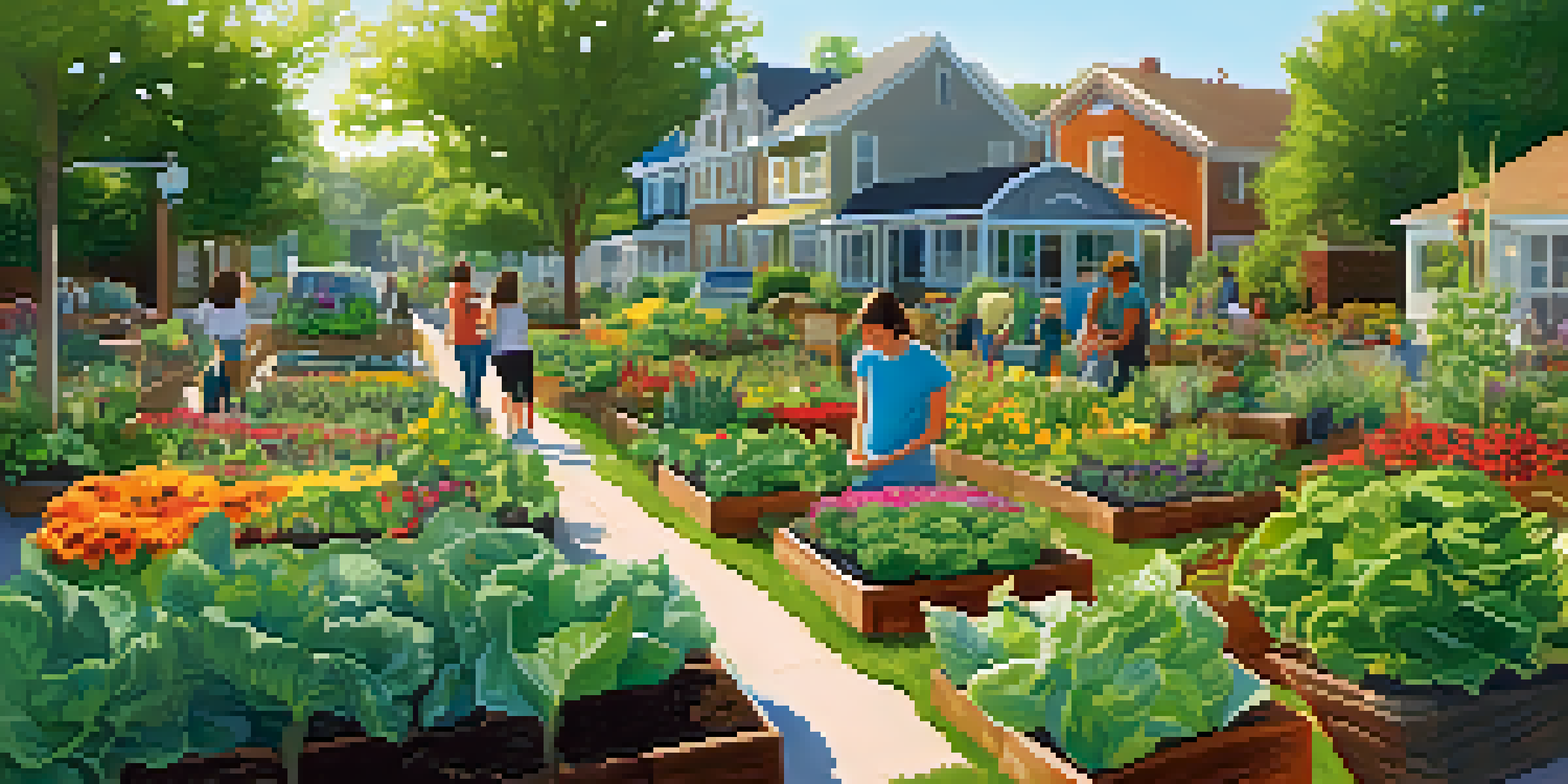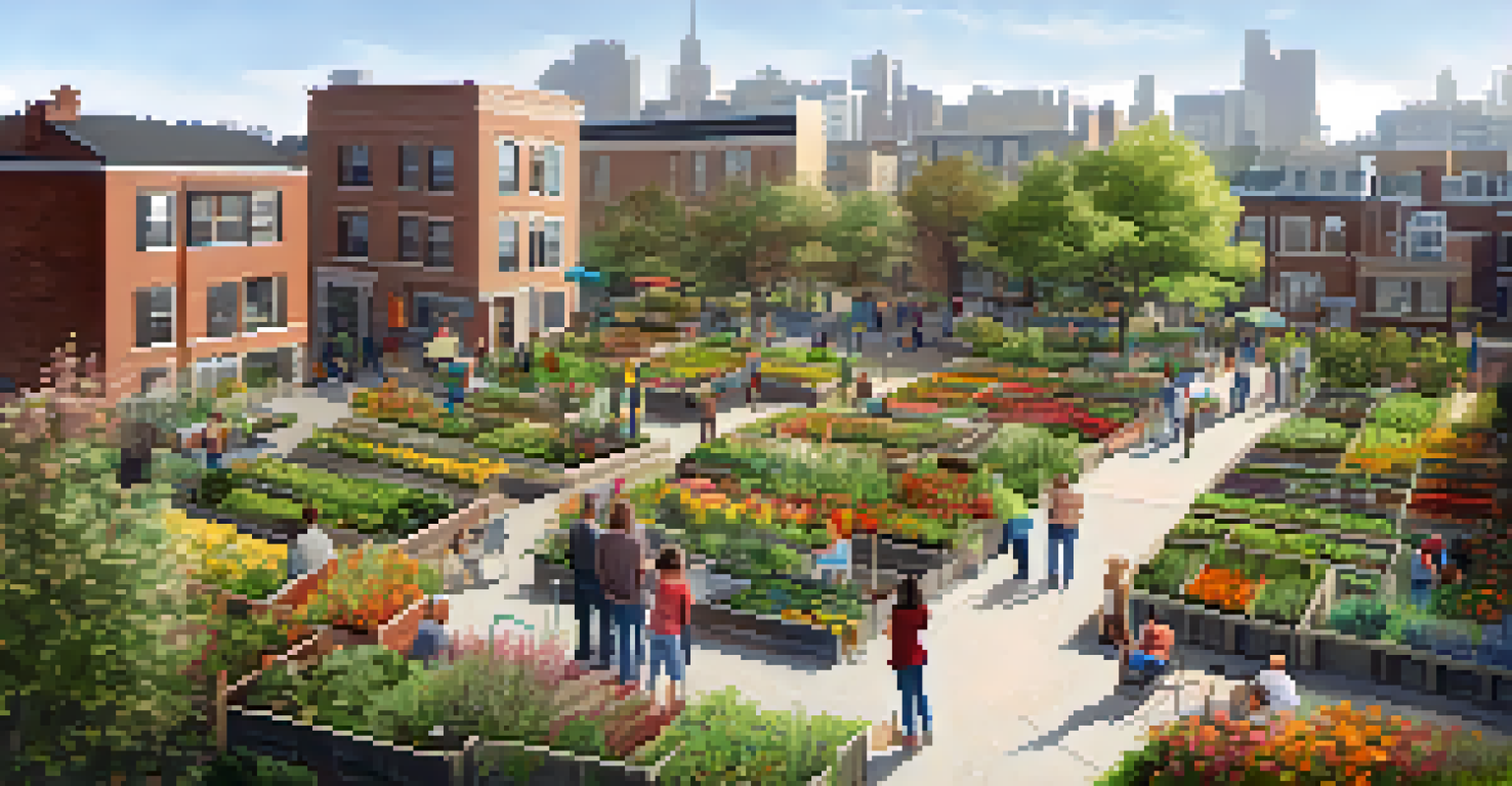How Community Gardening Fosters Sustainable Food Practices

Understanding Community Gardening and Its Benefits
Community gardening is more than just planting flowers or vegetables; it's a collaborative effort where neighbors come together to cultivate a shared space. These gardens can be found in urban and rural areas alike, serving as a hub for social interaction and environmental education. The beauty of community gardening lies in its ability to unite people around a common goal—growing food sustainably and fostering a sense of belonging.
Community gardens are a way to bring people together and connect them to their food sources.
By participating in community gardening, individuals learn about local food systems and sustainable practices firsthand. This hands-on experience can spark a deeper appreciation for where food comes from and the labor that goes into growing it. Furthermore, these gardens often prioritize organic growing methods, which not only benefit the environment but also promote healthier eating habits among community members.
As participants tend to their plots, they also cultivate relationships with fellow gardeners. These connections can lead to an exchange of knowledge, tips, and even seeds, creating a vibrant community of learning that extends beyond the garden. Ultimately, community gardening serves as a microcosm of how collective action can lead to sustainable food practices.
Promoting Biodiversity Through Shared Spaces
One of the main advantages of community gardening is its role in promoting biodiversity. When community members come together to grow a variety of plants, they create a rich ecosystem that supports various insects, birds, and other wildlife. This diversity is crucial for maintaining healthy soil and pest control, which in turn leads to more resilient food production.

In contrast to monoculture farming, where only one type of crop is planted, community gardens often embrace polyculture. This approach not only enhances biodiversity but also reduces the risk of pests affecting an entire crop. For example, planting flowers alongside vegetables can attract pollinators like bees, which helps both plants thrive.
Community Gardening Builds Bonds
Community gardening fosters social connections among neighbors, creating a sense of belonging and mutual support.
Additionally, community gardens can serve as a refuge for native plants that may be struggling in their natural habitats due to urbanization. By incorporating native species, these gardens can help restore local ecosystems and contribute to a healthier environment. In essence, community gardening fosters a flourishing biodiversity that benefits not just the gardeners, but the broader ecological landscape.
Educating the Community on Sustainable Practices
Community gardens are excellent platforms for education, offering workshops and events that teach members about sustainable gardening techniques. Topics may include composting, organic pest control, and water conservation, all of which are essential for growing food in an environmentally friendly way. This hands-on learning experience empowers individuals to adopt these practices in their own backyards.
When we garden together, we cultivate not just plants, but also community and resilience.
Moreover, children and young adults involved in community gardening gain invaluable lessons about nutrition and the importance of eating fresh, locally-grown food. Many gardens incorporate educational programs that teach about the life cycle of plants, helping to foster a sense of responsibility towards food sources and the environment. This early exposure often translates into lifelong habits of sustainability.
By sharing knowledge within the community, gardens create a ripple effect, encouraging healthier lifestyle choices among residents. As members become more informed about sustainable practices, they are more likely to advocate for local policies supporting sustainable agriculture and food access. In this way, community gardens play a vital role in nurturing an environmentally-conscious mindset.
Building Resilience in Food Systems
Community gardening contributes to building resilience in food systems by creating local sources of fresh produce. By growing food within their neighborhoods, communities can reduce their reliance on industrial agriculture and long supply chains. This shift not only lowers carbon emissions associated with transportation but also ensures that residents have access to nutritious food.
In times of crisis, such as natural disasters or economic downturns, community gardens can act as food security buffers. For instance, during the COVID-19 pandemic, many community gardens provided essential food supplies to those in need. This ability to adapt and provide for the community highlights the significance of having local food systems in place.
Promotes Biodiversity and Resilience
By cultivating diverse plants, community gardens enhance local ecosystems while contributing to resilient food systems.
Furthermore, community gardens encourage residents to share surplus produce, fostering a culture of generosity and support. This not only strengthens community ties but also ensures that food is not wasted. By cultivating resilience through local food production, community gardens become essential assets to their neighborhoods.
Encouraging Eco-Friendly Practices
Participating in community gardening often instills eco-friendly habits among gardeners. Practices such as composting kitchen scraps and using organic fertilizers become commonplace, as members recognize their positive impact on the environment. This shift towards sustainable practices helps reduce waste and minimizes the use of harmful chemicals in food production.
In addition, many community gardens implement water conservation techniques, such as rainwater harvesting and drip irrigation. These methods not only conserve precious water resources but also serve as educational tools for members to adopt similar strategies at home. The knowledge gained through community gardening can empower individuals to make environmentally-conscious decisions beyond the garden.
As gardeners witness the benefits of eco-friendly practices firsthand, they often become advocates for sustainability within their broader communities. This advocacy can lead to more widespread changes, influencing local policies and encouraging others to adopt greener lifestyles. In this way, community gardening plays a pivotal role in fostering a culture of environmental stewardship.
Strengthening Community Bonds
One of the most profound impacts of community gardening is its ability to strengthen social bonds among participants. As neighbors come together to plant, tend, and harvest, they build relationships based on shared interests and goals. These social interactions can help break down barriers, fostering a sense of belonging and mutual support within the community.
Community gardens often host events, such as potlucks or harvest festivals, further enhancing these connections. These gatherings create opportunities for residents to share stories, recipes, and gardening tips, reinforcing the social fabric of the neighborhood. The friendships formed in these gardens can lead to collaborative efforts on other community projects, amplifying the positive impact of their work.
Advocates for Food Justice
Community gardens help address food deserts by providing fresh produce and empowering residents to take control of their food sources.
Moreover, the inclusive nature of community gardening encourages participation from diverse groups, promoting cultural exchange and understanding. By celebrating different gardening traditions and cuisines, these gardens become melting pots of creativity and collaboration. Ultimately, the social benefits of community gardening extend far beyond the garden itself, nurturing a sense of unity and resilience.
Advocating for Food Justice and Access
Community gardening plays a crucial role in advocating for food justice, ensuring that everyone has access to fresh, healthy food. Many urban areas lack sufficient grocery stores, leading to food deserts where residents struggle to find nutritious options. Community gardens can bridge this gap by providing a direct source of fresh produce to those in need.
By organizing community-supported agriculture (CSA) programs or food giveaways, these gardens help distribute food to underserved populations. This initiative not only addresses immediate food needs but also empowers residents to take control of their food sources. When communities actively participate in growing their own food, they become more resilient against food insecurity.

Additionally, community gardens often collaborate with local organizations to advocate for policies that support food access and justice. By raising awareness about the importance of equitable food systems, these gardens can influence local government decisions and inspire broader community engagement. In this way, community gardening not only nourishes individuals but also fosters systemic change.
The Future of Community Gardening and Sustainability
As the world faces growing challenges related to climate change, community gardening offers a hopeful solution for building sustainable food systems. By nurturing relationships, promoting biodiversity, and educating communities, these gardens can lead the way in creating resilient local food networks. The future of community gardening is bright, as more individuals recognize its benefits and seek to get involved.
Moreover, advancements in technology and sustainable practices can enhance the efficiency and effectiveness of community gardens. Innovations such as vertical gardening and hydroponics can maximize space and yield, making urban gardening even more accessible. As communities adapt to changing circumstances, they can leverage these tools to further their sustainable food practices.
Ultimately, the movement towards community gardening is not just about growing food—it's about cultivating a sense of community and responsibility towards our environment. As more people join this movement, we can envision a future where sustainable food practices are the norm, and communities thrive together. Community gardening is not only a trend; it is a vital component of a sustainable future.